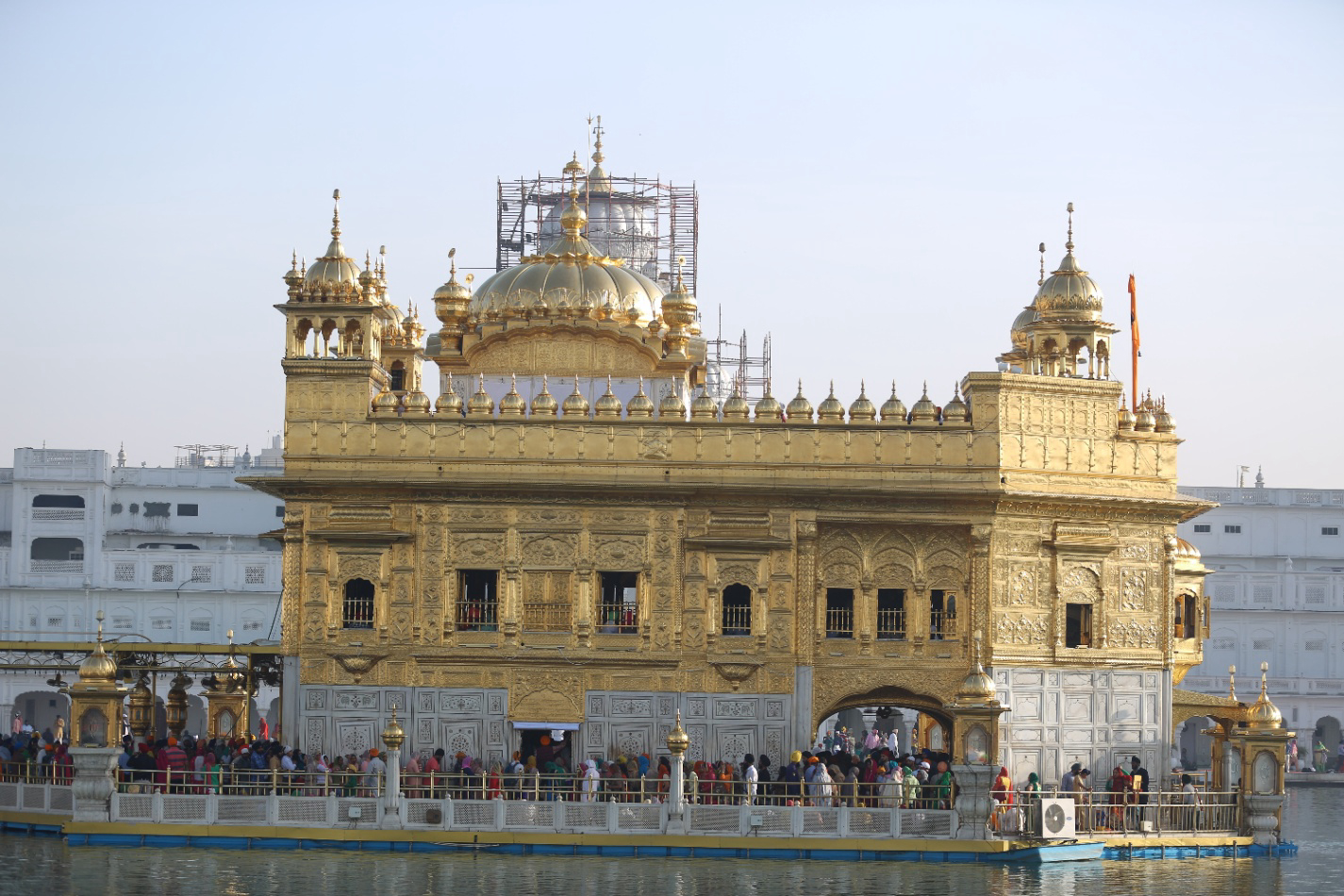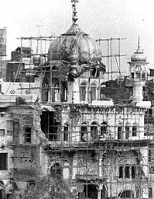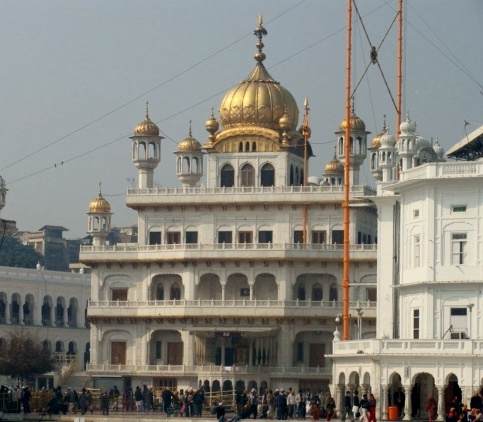
Golden Temple, Amritsar, Punjab, India
India is the biggest democratic country in the world and it also believes in “Unity in Diversity.” But at times, we can witness the other side of the coin through some horrible historical incidents. Several political and religious groups have been toy-playing with India's democracy since its independence. And the most suitable instance for this situation is the 1984s “Operation Blue Star,” which happened at one of the holiest places in India, Golden temple.
Situated in the heart of Amritsar, the golden temple, Harmandir Sahib, is the most valuable shrine in the country. It also played a vital part in the vibrant history of Punjab which makes this religious legacy the holiest pilgrimage site for all the Sikhs. The golden temple is surrounded by other elegant white temples and the canal. It is not a large temple, but its surroundings are relatively vast, Built-in 1577, the temple's dome is coated with 750 kg of pure gold. And this elegant place witnessed bloodshed due to the Operation Blue Star. It was a military project which was advised by Indira Gandhi, the then Prime Minister, to eliminate some Sikh militants who were attaining weapons in the Golden Temple Complex, in Amritsar, in order to define control over it. The operation was undertaken in reaction to a breakdown of law and order in Punjab.
The primary motive behind the Blue Star Operation was the “Khalistan movement" in Punjab. It was a political Sikh nationalist movement that wished for an independent state for Sikh people, inside the current North-Western Republic of India. The chief of the Damdami Taksal, “Jarnail Singh Bhindranwale”, who was another critical aspect which directed towards the Operation Blue Star. Bhindranwale had a tremendous influence on the Sikh youth in Punjab during that period. He exploited actual values of Sikhism and convinced people, both young and old to blindly follow the rules and principles created by him. Bhindranwale was widely recognized to be a believer for the creation of a Sikhism-based state of Khalistan. And thus, he is reported for his stake in Operation Blue Star, in which he and Khalistan supporters invaded Golden Temple, in Amritsar. The central goal of the Operation Blue Star was to terminate Jarnail Singh Bhindranwale, along with his supporters and retrieve the control over the Golden temple.
Operation Blue Star had two major components to it. The first one was Operation Metal, which was restricted to the Golden Temple complex. Operation Metal was followed by Operation Shop. It invaded the Punjab countryside, in order to capture other suspects. This operation was conducted by the Indian Army, using tanks, helicopters and other armoured vehicles. The entire operation lasted for ten days. It started on June 1, 1984, and ended on June 10, 1984. At first, 'Guru Ram Das Langar' building inside the Golden Temple was attacked by the Indian Army. And then estimated seven battalions of the army were deployed Punjab. Media confronted a blackout and transportation services underwent major trouble during that period. Outsiders were restricted and in many parts of Amritsar, water and electricity supply was cut off. Punjab also withstood an extensive curfew as the army and para-military were protecting around. Gurcharan Singh Tohra, former head of SGPC, was selected to negotiate with Bindrawale and his supporters. However, the negotiations had failed. Between this period many Sikh militants and other civilians died under the attack. On June 7, 1984, the Indian army gained control over the Harmandir Sahib complex. Bhindranwale and a large number of his militants were killed. There were high civilian casualties as well since militants used pilgrims trapped inside the temple as human shields. Officially, 493 Sikh militants and civilians were dead, and 83 Military soldiers were martyred including 4 officers and 79 soldiers, with 236 wounded others. Unofficial casualty figures were much greater.

Bhindranwale and his followers occupied Akal Takht in December 1983
Image Credit: en.wikipedia.org
Operation Blue Star was scheduled on a Sikh religious day, the martyrdom day of “Guru Arjan Dev”, the founder of the Harmandir Sahib. Sikhs from various part of the world pray at the temple on this sacred day. The pilgrims were not permitted by the militants to run away from the temple premises in spite of assistance in the curfew hours by the security forces. Many Sikhs regard the timing and attack by the army as a project to impose maximum casualties on Sikhs and demoralise them, and the government is in turn blamed for the excessive number of civilian deaths by preferring to strike on that day. The operation has been criticised on multiple aspects involving, the government's preference of timing for the attack, the massive deaths and statements of human rights offences. But the repercussions of this event lasted for an even longer time, the assassination of Indira Gandhi was the broadly striking event associated with the Operation Blue Star. Indira Gandhi was assassinated on October 31, 1984, four months after the Operation Blue Star. She was shot dead by two of her Sikh bodyguards, Satwant Singh and Beant Singh. 33 rounds of bullets were fired on Indira Gandhi. The major reason for the assassination is the Operation Blue Star, which was ordered by her. And this assassination led to a more tragic incident, which was the “Anti-Sikh Riots” across India. (Source - Wikipedia)

Photograph of Akal Takht after Operation Blue Star
Image Credit: en.wikipedia.org
After the assassination of Indira Gandhi, anti-Sikh riots took place on 1 November 1984. It went on for a few days. Several groups of people used knives, iron rods and explosive material such as kerosene and petrol. They assaulted their Sikh neighbourhoods, brutally slaughtering any Sikh men, women and children they could find. Multiple Sikh shops and houses were demolished and burned. Some armed groups also ceased buses and trains, in and around Delhi and pulled out Sikh passengers, who were burnt alive. Others were dragged out from their residences and assaulted with bladed weapons. This riot took lives of more than 3,000 Sikhs. (Source - Wikipedia)
This particular series of events, which happened due to some communal and government conflicts, took the lives of numerous people. And it never changed anything, it neither ended terrorism, nor religious politics. A relatively practical lesson understood by this is that political groups must never take advantage of politics with religious beliefs of people, while religious leaders must assure that locations of worship are never misused for something like this.
